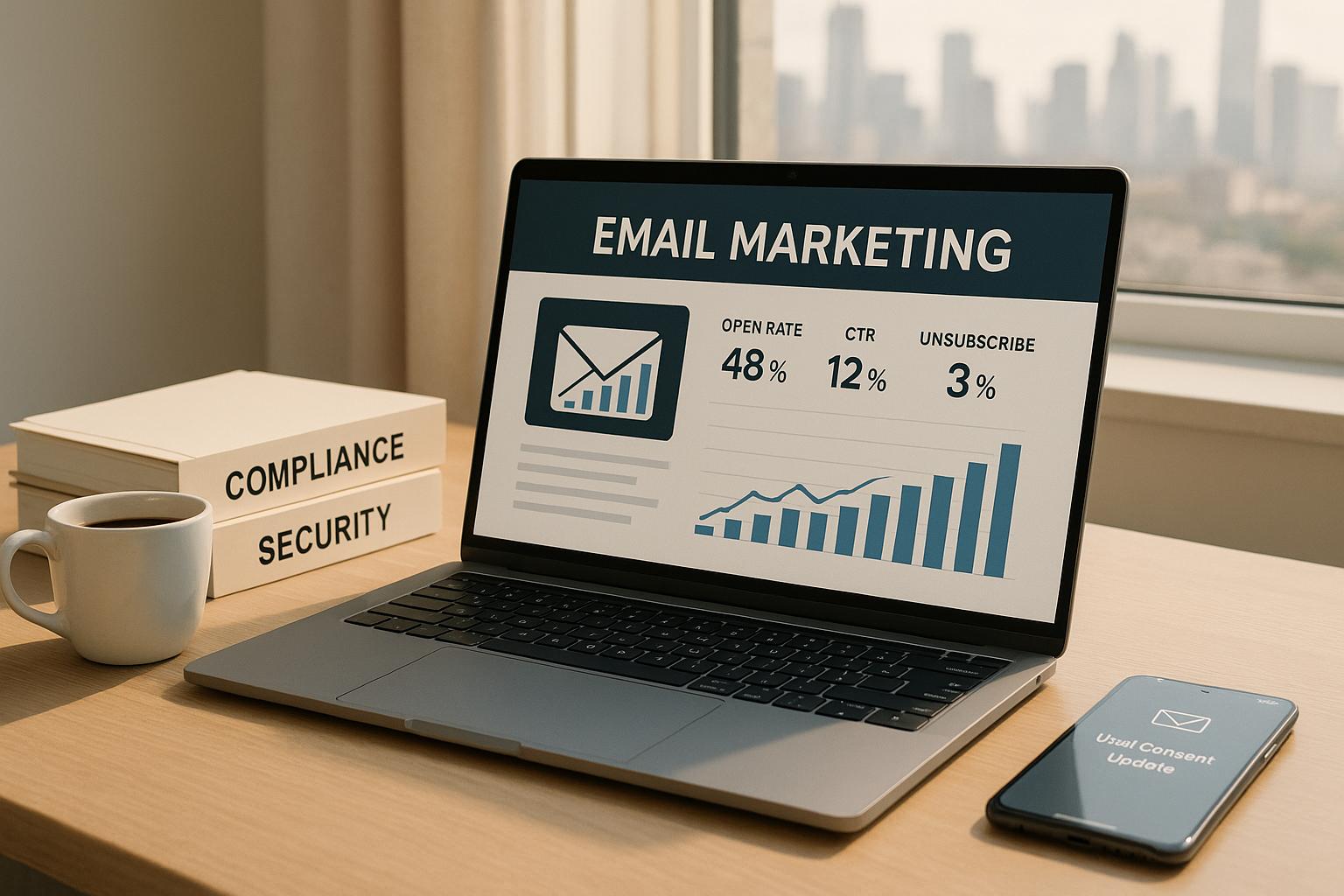Email privacy is critical for businesses to comply with regulations like GDPR and CCPA. To protect sensitive data while maintaining its usefulness, companies often use these three anonymization techniques:
- Data Masking: Replaces sensitive details with fake data, useful for testing environments.
- Pseudonymization: Substitutes personal identifiers with pseudonyms, retaining analytics capabilities.
- Encryption: Converts data into secure formats, ensuring top-level protection for sensitive information.
Each method has its strengths. For example, masking is simple and budget-friendly, pseudonymization balances privacy and usability, and encryption offers the highest security for sensitive data. Many organizations combine these strategies for robust compliance and data protection.
Here’s a quick comparison:
| Method | Key Benefit | Best Use Case |
|---|---|---|
| Data Masking | Easy setup, retains structure | Testing environments |
| Pseudonymization | Balances privacy and analytics | Behavioral and campaign analysis |
| Encryption | Maximum security | Highly sensitive data |
To stay compliant, businesses should regularly update their strategies, train staff, and combine these techniques for layered protection.
Related video from YouTube
1. Data Masking
Data masking is a method used to protect sensitive information by replacing it with altered, yet usable, data. In email marketing, this technique helps businesses meet legal requirements like GDPR and CCPA while still keeping data useful for analysis.
Email marketers typically rely on three main techniques:
| Technique | How It Works | Effect on Data Utility | Privacy Level |
|---|---|---|---|
| Character Scrambling | Alters email addresses (e.g., "john.doe@example.com" becomes "XXXX.XXXX@XXXXX.com") | Keeps the format but limits analytics | High |
| Synthetic Generation | Produces realistic, fake data that mimics original patterns | Retains analytics capabilities | Moderate |
| Data Shuffling | Randomly rearranges values within a dataset column | Preserves statistical properties | Moderate |
These methods allow marketers to track campaign performance while staying compliant. Success with data masking depends on identifying sensitive information and applying masking patterns that maintain data functionality for segmentation and analysis. This ensures that masked email lists can still support marketing efforts without exposing personal details.
2. Pseudonymization
Pseudonymization is a method that enhances email privacy by substituting personal identifiers with artificial ones, while keeping a separate mapping table for potential re-identification. Unlike data masking, which is irreversible, pseudonymization allows for re-identification if necessary, offering flexibility for analysis.
This technique involves replacing email addresses with pseudonyms stored in a secure mapping table. This approach allows data analysis without revealing the original information.
Here's a comparison of various pseudonymization methods in email marketing:
| Method | Implementation | Data Utility | Privacy Level | Best Use Case |
|---|---|---|---|---|
| Consistent Reversible | Generates fixed pseudonyms using algorithms | High | Moderate | Tracking customer journeys |
| Randomized Reversible | Creates random pseudonyms with a mapping table | Moderate | High | A/B testing campaigns |
| Tokenization | Replaces values with non-algorithmic tokens | High | High | Tracking transactions |
| Dynamic | Periodically updates pseudonyms | Moderate | Very High | Time-sensitive campaigns |
These methods align with GDPR's focus on minimizing data usage while maintaining valuable campaign insights.
Top tools like K2view and Broadcom offer pseudonymization features tailored for email marketing compliance [1][2].
To effectively implement pseudonymization and remain compliant:
- Store mapping tables separately from pseudonymized data.
- Conduct regular security audits for both datasets.
- Limit access to the mapping table to authorized personnel only.
For example, a major European retailer successfully maintained 98% of their email analytics capabilities while meeting GDPR requirements by combining consistent reversible pseudonymization with strict access controls [1].
Many organizations also pair pseudonymization with encryption to ensure full compliance [3].
sbb-itb-6e7333f
3. Encryption
Encryption takes data protection to the next level by converting sensitive information into unreadable ciphertext, which can only be accessed with specific decryption keys. This approach builds on pseudonymization but offers a stronger safeguard for email privacy compliance.
Modern platforms typically rely on three main types of encryption:
| Encryption Type | How It Works | Best Use Case | Compliance Benefits |
|---|---|---|---|
| Symmetric (AES) | Uses a single key for encryption and decryption | Securing stored customer data | High - aligns with GDPR/HIPAA |
| Asymmetric (RSA) | Employs a key pair for secure data transfer | Protecting email transmissions | Very High - ensures end-to-end security |
| Homomorphic | Allows computations on encrypted data | Privacy-preserving analytics | Maximum - processes data securely |
Platforms now automate many encryption processes, making compliance easier. Homomorphic encryption, for instance, lets marketers analyze encrypted data without exposing it, balancing privacy and functionality.
Here’s how to implement encryption effectively:
- Key Management: Develop strong protocols for storing and rotating encryption keys.
- End-to-End Protection: Encrypt data both at rest and during transfer.
- Regular Updates: Stay ahead of threats by using the latest encryption standards.
Though encryption can be more resource-intensive than methods like masking or pseudonymization, its ability to secure personal data - including metadata - and ensure compliance often justifies the investment. To maximize effectiveness, organizations should:
- Safeguard all types of personal data.
- Ensure compatibility across different platforms.
- Test encryption systems regularly.
Encryption works best when paired with other techniques, especially for maintaining GDPR-compliant analytics capabilities.
Pros and Cons
Organizations evaluate the strengths and weaknesses of each anonymization method to make informed decisions. This analysis builds on the technical approaches discussed earlier, offering a clear comparison to guide strategic choices.
| Strategy | Advantages | Disadvantages | Operational Requirements |
|---|---|---|---|
| Data Masking | • Easy to set up and manage • Keeps data structure intact • Budget-friendly • Minimal impact on performance |
• Limited defense against inference attacks • May not satisfy strict compliance rules • Less effective for complex data relationships |
• Quick to deploy • Requires few resources • Minimal staff training needed |
| Pseudonymization | • Retains data usability • Supports analytical tasks • Allows controlled re-identification |
• Relies on secure mapping table management • Re-identification risk if mapping is exposed • Higher operational effort |
• Moderate complexity • Additional storage space needed • Requires ongoing mapping table upkeep |
| Encryption | • Provides top-level security • Meets GDPR/CCPA standards • Protects data in storage and transit |
• Resource-intensive • Complex key management • Can slow down system performance |
• Requires advanced technical expertise • Higher implementation costs • Needs continuous maintenance |
Homomorphic encryption, while offering unmatched privacy protection, introduces about a 30% processing overhead compared to standard encryption methods.
The choice of strategy often depends on the industry and specific organizational needs. Many companies combine methods to achieve their goals. For example, data masking may be used for less sensitive data, while encryption is applied to critical customer information.
Key Considerations
When selecting an anonymization approach, focus on these factors:
- Balance technical capabilities and compliance requirements with the need for data usability.
- Ensure scalability to accommodate future growth and changes.
Platforms with built-in anonymization tools typically reduce implementation time by around 40% compared to custom-built solutions. Combining multiple methods in a layered approach often yields the best results, ensuring both security and flexibility.
Conclusion
When deciding on anonymization methods, it's crucial to align your approach with specific use cases and business needs. Here are the key takeaways from our analysis:
- Data masking can reduce implementation time by 40%, making it a great choice for companies with basic compliance requirements or lower-risk data environments.
- Pseudonymization retains up to 95% of analytics capabilities while meeting compliance needs. This is especially useful in scenarios like email marketing, where behavioral analysis plays a key role.
- Encryption is the go-to option for handling highly sensitive customer data or operating in heavily regulated industries. While it demands more resources, the added security makes it worth the investment.
A combined approach often works best. For example, a three-tier model - using encryption for storage, pseudonymization for analytics, and masking for testing environments - has proven highly effective. Many organizations also enhance privacy by incorporating synthetic data generation into their strategies.
Reports show that organizations adopting comprehensive strategies see a 60% drop in privacy-related incidents. To achieve this, consider these implementation steps:
- Regularly review and update your strategies to meet changing regulations.
- Provide staff with training to ensure proper application of these methods.
Ultimately, the most effective approach involves layering multiple methods rather than relying on a single solution. By tailoring these methods to your business needs, you can ensure compliance and robust data protection.
FAQs
What are the types of data anonymization techniques?
In email marketing, data anonymization often relies on three main techniques designed to meet compliance standards. Here's a quick breakdown:
| Technique | Description | Best Use Case |
|---|---|---|
| Data Masking | Replaces sensitive information with realistic but fictional data. | Ideal for testing environments and meeting basic compliance. |
| Pseudonymization | Swaps identifiers with pseudonyms while keeping a separate mapping table. | Useful for analytics and behavioral analysis. |
| Encryption | Converts sensitive data into unreadable ciphertext, accessible only with specific keys. | Best for high-security needs and strict compliance. |
Each method has its strengths, so choose based on how much privacy and data utility your campaign requires. Always align with GDPR's data minimization principle to ensure compliance.


